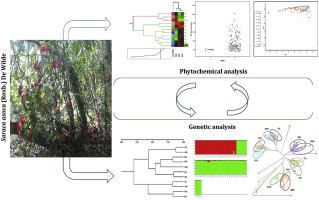当前位置:
X-MOL 学术
›
Phytochemistry
›
论文详情
Our official English website, www.x-mol.net, welcomes your feedback! (Note: you will need to create a separate account there.)
Genetic and phytochemical investigations for understanding population variability of the medicinally important tree Saraca asoca to help develop conservation strategies
Phytochemistry ( IF 3.8 ) Pub Date : 2018-12-01 , DOI: 10.1016/j.phytochem.2018.08.016 Satisha Hegde , Sandeep Ramchandra Pai , Rasika M. Bhagwat , Archana Saini , Poonam Kanwar Rathore , Sunil Satyappa Jalalpure , Harsha Vasudev Hegde , Attayoor Purushottaman Sugunan , Vidya S. Gupta , Sanjiva D. Kholkute , Subarna Roy
Phytochemistry ( IF 3.8 ) Pub Date : 2018-12-01 , DOI: 10.1016/j.phytochem.2018.08.016 Satisha Hegde , Sandeep Ramchandra Pai , Rasika M. Bhagwat , Archana Saini , Poonam Kanwar Rathore , Sunil Satyappa Jalalpure , Harsha Vasudev Hegde , Attayoor Purushottaman Sugunan , Vidya S. Gupta , Sanjiva D. Kholkute , Subarna Roy

|
Saraca asoca (Roxb.) De Wilde (Caesalpiniaceae) is a highly traded IUCN red listed tree species used in Ayurvedic medicines for the treatment of various disorders, especially gynaecological problems. However, information about the genetic variations between populations and corresponding variation in specialized metabolites of S. asoca remains unclear. To address this issue, we analysed 11 populations of S. asoca with 106 accessions collected from Western Ghats of India using ISSR markers along with selected phytocompounds using RP-HPLC. Twenty primers were screened, out of which seven were selected for further analysis based on generation of clear polymorphic banding patterns. These seven ISSR primers produced 74 polymorphic loci. AMOVA showed 43% genetic variation within populations and 57% among the populations of S. asoca. To estimate the genetic relationships among S. asoca populations, UPGMA and Bayesian Models were constructed, which revealed two clusters of similar grouping patterns. However, excluding minor deviations, UPGMA and dissimilarity analysis showed close association of genotypes according to their geographical locations. Catechin (CAT), epicatechin (EPI) and gallic acid (GA) were quantified from bark and leaf samples of corresponding genotypes collected from 106 accessions. ROC plots depicted the sensitivity and specificity of the concentrations of tested phytocompounds at various cut-off points. Although, multiple logistic regression analysis predicted some association between few loci with GA, EPI and CAT, but PCA for phytochemical data failed to distinguish the populations. Overall, there were no significant trends observed to distinguish the populations based on these phytocompounds. Furthermore, the study advocates the delineate provenance regions of S. asoca genotypes/chemotype snapshots for in-situ conservation and ex-situ cultivation.
中文翻译:

用于了解具有重要药用价值的树 Saraca asoca 的种群变异性的遗传和植物化学研究,以帮助制定保护策略
Saraca asoca (Roxb.) De Wilde (Caesalpiniaceae) 是一种高度交易的 IUCN 红色名录树种,用于阿育吠陀药物治疗各种疾病,尤其是妇科问题。然而,关于群体之间的遗传变异和 S. asoca 专门代谢物的相应变异的信息仍不清楚。为了解决这个问题,我们使用 ISSR 标记分析了从印度西高止山脉收集的 106 个种质的 11 个 S. asoca 种群,并使用 RP-HPLC 分析了选定的植物化合物。筛选了 20 条引物,根据清晰的多态性条带模式的产生,从中选择了 7 条进行进一步分析。这七个 ISSR 引物产生了 74 个多态性位点。AMOVA 在种群内显示 43% 的遗传变异,在 S. asoca 种群中显示 57%。为了估计 S. asoca 种群之间的遗传关系,构建了 UPGMA 和贝叶斯模型,揭示了两个相似分组模式的集群。然而,排除微小偏差,UPGMA 和相异性分析显示基因型根据其地理位置密切相关。儿茶素 (CAT)、表儿茶素 (EPI) 和没食子酸 (GA) 从 106 份收集的相应基因型的树皮和叶子样品中定量。ROC 图描绘了测试的植物化合物在不同截止点的浓度的敏感性和特异性。虽然,多元逻辑回归分析预测少数基因座与 GA、EPI 和 CAT 之间存在某种关联,但植物化学数据的 PCA 未能区分种群。全面的,没有观察到根据这些植物化合物区分种群的显着趋势。此外,该研究提倡为就地保护和异地栽培划定 S. asoca 基因型/化学型快照的来源区域。
更新日期:2018-12-01
中文翻译:

用于了解具有重要药用价值的树 Saraca asoca 的种群变异性的遗传和植物化学研究,以帮助制定保护策略
Saraca asoca (Roxb.) De Wilde (Caesalpiniaceae) 是一种高度交易的 IUCN 红色名录树种,用于阿育吠陀药物治疗各种疾病,尤其是妇科问题。然而,关于群体之间的遗传变异和 S. asoca 专门代谢物的相应变异的信息仍不清楚。为了解决这个问题,我们使用 ISSR 标记分析了从印度西高止山脉收集的 106 个种质的 11 个 S. asoca 种群,并使用 RP-HPLC 分析了选定的植物化合物。筛选了 20 条引物,根据清晰的多态性条带模式的产生,从中选择了 7 条进行进一步分析。这七个 ISSR 引物产生了 74 个多态性位点。AMOVA 在种群内显示 43% 的遗传变异,在 S. asoca 种群中显示 57%。为了估计 S. asoca 种群之间的遗传关系,构建了 UPGMA 和贝叶斯模型,揭示了两个相似分组模式的集群。然而,排除微小偏差,UPGMA 和相异性分析显示基因型根据其地理位置密切相关。儿茶素 (CAT)、表儿茶素 (EPI) 和没食子酸 (GA) 从 106 份收集的相应基因型的树皮和叶子样品中定量。ROC 图描绘了测试的植物化合物在不同截止点的浓度的敏感性和特异性。虽然,多元逻辑回归分析预测少数基因座与 GA、EPI 和 CAT 之间存在某种关联,但植物化学数据的 PCA 未能区分种群。全面的,没有观察到根据这些植物化合物区分种群的显着趋势。此外,该研究提倡为就地保护和异地栽培划定 S. asoca 基因型/化学型快照的来源区域。



























 京公网安备 11010802027423号
京公网安备 11010802027423号